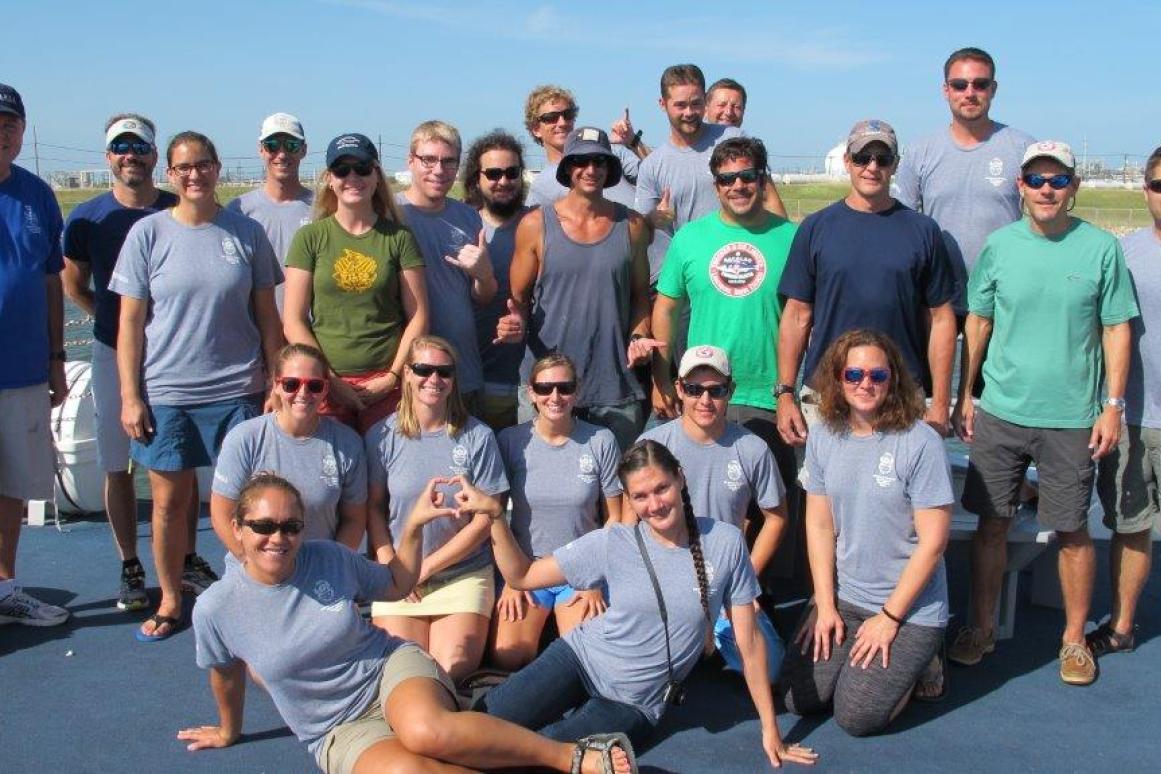2015 Coral Spawn Cruise

Each summer, students and scientists at the Harte Research Institute (HRI) for Gulf of Mexico Studies at Texas A&M University-Corpus Christi watch extraordinary life bloom in the Gulf of Mexico. HRI master’s and doctoral students and researchers travelled to the Flower Gardens National Marine Sanctuary Aug. 6-9 to dive the annual coral spawn, which is considered one of the most spectacular events in the biological world.
"My goal in bringing our students and researchers to witness this special event is remind them why HRI exists and why what they do matters,” said Dr. Larry McKinney, HRI executive director and organizer of the annual event, "It is a unique opportunity to literally immerse yourself in something that is more than just science — it's life at its fullest and most meaningful."
The coral spawn, occurring nine days after the first full moon in August, is triggered by the light of the moon and sun. The Flower Gardens sanctuary is a series of coral-topped submerged banks 110 miles off the Texas coast that are considered some of the healthiest coral reefs in the Gulf of Mexico and Caribbean. The banks contain a higher percentage of living coral coverage than any other reefs outside the Indo-Pacific, exceeding 50 percent, and reproduce in a mass spawn that is uniquely intense and grand.
The group of 20 or more divers don SCUBA gear and slip into the water sometime between 9 p.m. and midnight, hoping to capture what few people ever see. Swimming slowly over the 354-acre reef, they use powerful lights to sweep the water just above the coral looking for the small, pellet-like eggs that will float towards the surface of the ocean. During the spawn, the eggs stream off coral heads, sometimes exploding forth all at once from huge coral heads the size of a Volkswagen, McKinney said. In waters more than 60-feet deep, divers watch individual corals fire off and release their eggs until the effect becomes something like an underwater blizzard. Fish, shrimp, brittle stars, marine worms and other species feast on the bounty in frenzy. As quickly as the mass spawn begins, it is over. Species that missed the event or have different light cues will continue to spawn periodically, hoping to connect with another member of its species.
Each coral species somehow times its release for maximum benefit by avoiding the simultaneous spawning of other species. Scientists believe that these mass spawning events are designed to allow genetic mixing and dispersal of offspring over large distances. The sheer volume of a mass spawning allows for the survival of a significant number of larvae despite the best efforts of predators.
“It’s an amazing experience to spend all day diving and seeing new species and seeing how fish and organisms interact. There’s always something new to see; a new species or behavior,” said HRI Research Associate Terry Palmer, who made his fifth dive trip. “This is an opportunity that is difficult to get otherwise — The chance to hang out with a lot of great scientists and the opportunity to see something that’s unique in the Gulf and Caribbean, something so pristine.”
The group dives four to five times a day for several days to take in the spawn, an exhausting but rewarding schedule. HRI doctoral student Lauren Hutchison, who has made the trip to the Flower Gardens several times, described the night dives as exciting and a little bit spooky.
“The species on the reef at night are different than the species you see during the day. Compared to their daytime counterparts, these species seem unfamiliar and more alien in nature,” Hutchison said. “At night, you see many kinds of urchins, sea stars and sea cucumbers crawling around at a slow, almost eerie pace. At times, you feel movement around you, but by the time you shine your light in the direction of the movement, nothing is there. I find it especially fun to turn my light off and observe the bioluminescence around me.”
The annual expedition is designed to inspire the students, giving them a chance to break away from books to experience one of the Gulf’s natural wonders.
Hutchison said that after being immersed in a mass spawn during her dive this year, the experience will stay with her for the rest of her life.
“Toward the end of our dive, my dive buddy and I stayed at one very large coral head for almost 10 minutes. We watched it release its eggs and stayed to watch other corals around it swell and start to release their eggs as well,” Hutchison said. “As we made our way back toward the boat, the coral was spawning all around us. If only we had more air and could have stayed down for a bit longer. On the surface, the smell of fish was very strong and there was a large slick of eggs next to the boat. This experience is one of the most amazing experiences of my life, which is why it is hard for me to pass up a coral spawn expedition.”
